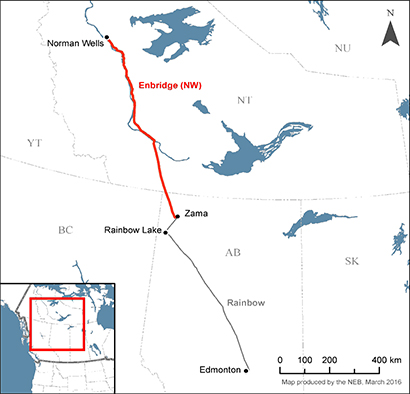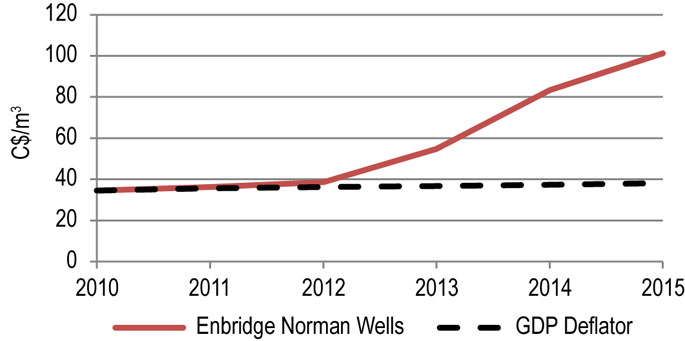Canada’s Pipeline Transportation System 2016
Enbridge Pipelines (NW) Inc.’s Enbridge Norman Wells Pipeline
| Commodity and NEB Group | Crude Oil (Group 1) |
| Operating capacity | 5087 m³/d (32 Mb/d) |
| Average utilization 2015 | 24% |
| Primary receipt points | Norman Wells, NT |
| Primary delivery points | Zama, AB. |
| Abandonment Cost Estimate and Collection PeriodNote a | $37 million; 11 years |
Overview
The Enbridge Norman Wells Pipeline (Norman Wells) is 869 km in length and was commissioned in 1985 to transport crude oil from Imperial Oil’s facility in Norman Wells, NT to Zama in northern Alberta.

Source: NEB
Text version of this map
This map provides an overview of the Norman Wells Pipeline System.
Key Developments
After a crude oil release on Norman Wells in May 2011, the Board issued an order (SO-102-002-2011) to Enbridge Pipelines (NW) Inc., imposing a restriction on the maximum operating pressure of the pipeline and requiring an engineering assessment of the pipeline to ascertain its integrity. The Board subsequently issued Order AO-001-SO-E102-002-2011 in March 2013, requiring a further pressure restriction. An additional Order AO-002-SO-E102-002-2011 from May 2013 maintained the existing pressure restrictions and instructed the company to perform an additional engineering assessment of the Wrigley to Mackenzie pipeline leg. After verifying that engineering assessments were performed and corrective measures were implemented, the Board granted order MO-066-2015 in November 2015, lifting the pressure restrictions.
Utilization
Figure 8.6.1 shows that Norman Wells average throughput was 2 200 m³/d (14 Mb/d) in 2014 and 1 900 m³/d (12 Mb/d) in 2015.
Figure 8.6.1: Norman Wells Throughput vs. Capacity

Sources: Enbridge, NEB
Text version of this graphic
This bar chart shows throughput and capacity for the Norman Wells Pipeline between 2010 and 2015. Capacity in 2015 was 7.9 10³m³/d (50 Mb/d). Throughput averaged 1.9 10³m³/d (12 Mb/d) in 2015, compared to 2.2 10³m³/d (14 Mb/d) in 2014.
Tolls
Figure 8.6.2 shows the Norman Wells benchmark toll (Norman Wells to Zama) and the GDP deflator (normalized) for 2010-2015. The benchmark toll increased 42% in 2013, 52% in 2014, and 21% in 2015. These significant toll increases can be attributed to decreasing throughput and increased integrity spending.
Figure 8.6.2: Norman Wells Benchmark Toll

Sources: NEB
Text version of this graphic
This graph shows the Enbridge Norman Wells benchmark toll as a solid red line and the GDP deflator as a black dashed line. The graph shows a slight increase in tolls from approximately $34.50 in 2010 to approximately $38.50 in 2012 followed by a significant toll increase from approximately $55.00 in 2013 to approximately $101.00 in 2015.
Financial
Norman Wells uses a traditional cost of service methodology in rate making and is regulated on a complaint basis. Norman Wells and its shippers continue to use the RH-2-94 formula to set the return on equity that is incorporated into the pipeline’s cost of service.
Credit ratings are not available for Enbridge Pipelines (NW) Inc. Enbridge Pipelines (NW) Inc. is a fully owned subsidiary of Enbridge Pipelines Inc. Norman Wells’ credit is strongly related to that of its anchor shipper, Imperial Oil Ltd., which, at the time of writing, DBRS had assigned a rating of ‘AA’.
| Enbridge Pipelines (NW) Inc. | 2010 | 2011 | 2012 | 2013 | 2014 | 2015 |
|---|---|---|---|---|---|---|
| Cost of Service (millions) | $32.17 | $75.03 | $46.81 | $65.43 | $69.21 | $61.84 |
| Rate Base (millions) | $113.4 | $108.7 | $110.0 | $141.1 | $162.3 | $150.9 |
| Approved Return on Equity | 8.46% | 8.08% | 7.58% | 7.23% | 7.93% | 7.64% |

- Date modified:
